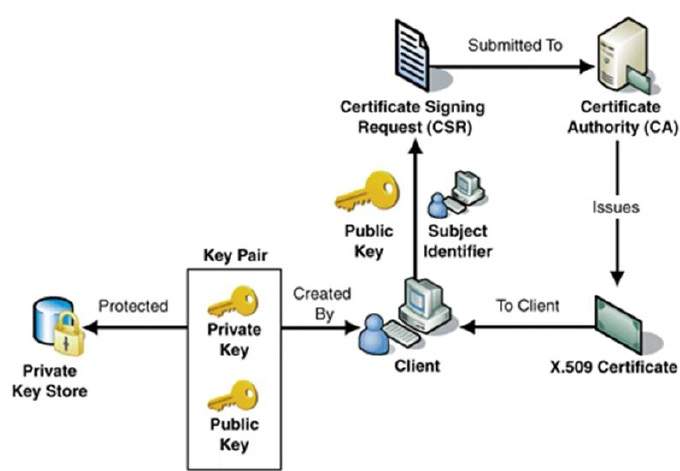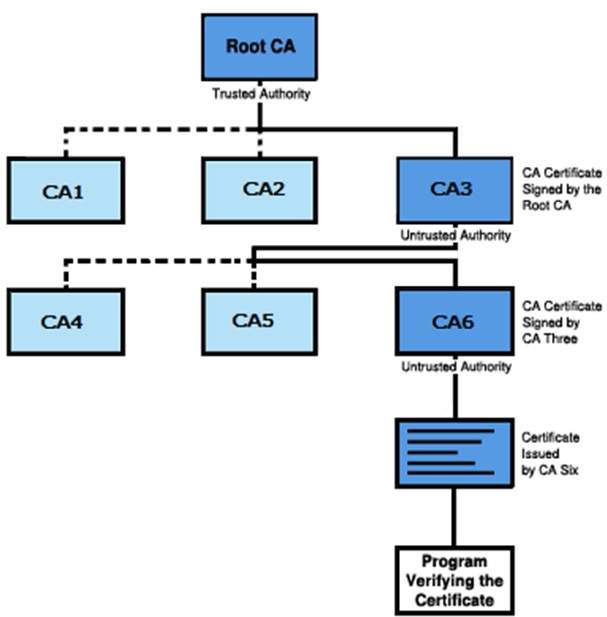For analogy, a certificate can be considered as the ID card issued to the person. People use ID cards such as a driver's license, passport to prove their identity. A digital certificate does the same basic thing in the electronic world, but with one difference.
Digital Certificates are not only issued to people but they can be issued to computers, software packages or anything else that need to prove the identity in the electronic world.
- Digital certificates are based on the ITU standard X.509 which defines a standard certificate format for public key certificates and certification validation. Hence digital certificates are sometimes also referred to as X.509 certificates.Public key pertaining to the user client is stored in digital certificates by The Certification Authority (CA) along with other relevant information such as client information, expiration date, usage, issuer etc.
- CA digitally signs this entire information and includes digital signature in the certificate.
- Anyone who needs the assurance about the public key and associated information of client, he carries out the signature validation process using CA’s public key. Successful validation assures that the public key given in the certificate belongs to the person whose details are given in the certificate.
The process of obtaining Digital Certificate by a person/entity is depicted in the following illustration.

As shown in the illustration, the CA accepts the application from a client to certify his public key. The CA, after duly verifying identity of client, issues a digital certificate to that client.
Certifying Authority (CA)
As discussed above, the CA issues certificate to a client and assist other users to verify the certificate. The CA takes responsibility for identifying correctly the identity of the client asking for a certificate to be issued, and ensures that the information contained within the certificate is correct and digitally signs it.
Key Functions of CA
The key functions of a CA are as follows −
- Generating key pairs − The CA may generate a key pair independently or jointly with the client.
- Issuing digital certificates − The CA could be thought of as the PKI equivalent of a passport agency − the CA issues a certificate after client provides the credentials to confirm his identity. The CA then signs the certificate to prevent modification of the details contained in the certificate.
- Publishing Certificates − The CA need to publish certificates so that users can find them. There are two ways of achieving this. One is to publish certificates in the equivalent of an electronic telephone directory. The other is to send your certificate out to those people you think might need it by one means or another.
- Verifying Certificates − The CA makes its public key available in environment to assist verification of his signature on clients’ digital certificate.
- Revocation of Certificates − At times, CA revokes the certificate issued due to some reason such as compromise of private key by user or loss of trust in the client. After revocation, CA maintains the list of all revoked certificate that is available to the environment.
Classes of Certificates
There are four typical classes of certificate −
- Class 1 − These certificates can be easily acquired by supplying an email address.
- Class 2 − These certificates require additional personal information to be supplied.
- Class 3 − These certificates can only be purchased after checks have been made about the requestor’s identity.
- Class 4 − They may be used by governments and financial organizations needing very high levels of trust.
Registration Authority (RA)
CA may use a third-party Registration Authority (RA) to perform the necessary checks on the person or company requesting the certificate to confirm their identity. The RA may appear to the client as a CA, but they do not actually sign the certificate that is issued.
Certificate Management System (CMS)
It is the management system through which certificates are published, temporarily or permanently suspended, renewed, or revoked. Certificate management systems do not normally delete certificates because it may be necessary to prove their status at a point in time, perhaps for legal reasons. A CA along with associated RA runs certificate management systems to be able to track their responsibilities and liabilities.
Private Key Tokens
While the public key of a client is stored on the certificate, the associated secret private key can be stored on the key owner’s computer. This method is generally not adopted. If an attacker gains access to the computer, he can easily gain access to private key. For this reason, a private key is stored on secure removable storage token access to which is protected through a password.
Different vendors often use different and sometimes proprietary storage formats for storing keys. For example, Entrust uses the proprietary .epf format, while Verisign, GlobalSign, and Baltimore use the standard .p12 format.
Hierarchy of CA
With vast networks and requirements of global communications, it is practically not feasible to have only one trusted CA from whom all users obtain their certificates. Secondly, availability of only one CA may lead to difficulties if CA is compromised.
In such case, the hierarchical certification model is of interest since it allows public key certificates to be used in environments where two communicating parties do not have trust relationships with the same CA.
- The root CA is at the top of the CA hierarchy and the root CA's certificate is a self-signed certificate.
- The CAs, which are directly subordinate to the root CA (For example, CA1 and CA2) have CA certificates that are signed by the root CA.
- The CAs under the subordinate CAs in the hierarchy (For example, CA5 and CA6) have their CA certificates signed by the higher-level subordinate CAs.
Certificate authority (CA) hierarchies are reflected in certificate chains. A certificate chain traces a path of certificates from a branch in the hierarchy to the root of the hierarchy.
The following illustration shows a CA hierarchy with a certificate chain leading from an entity certificate through two subordinate CA certificates (CA6 and CA3) to the CA certificate for the root CA.

Verifying a certificate chain is the process of ensuring that a specific certificate chain is valid, correctly signed, and trustworthy. The following procedure verifies a certificate chain, beginning with the certificate that is presented for authentication −
- A client whose authenticity is being verified supplies his certificate, generally along with the chain of certificates up to Root CA.
- Verifier takes the certificate and validates by using public key of issuer. The issuer’s public key is found in the issuer’s certificate which is in the chain next to client’s certificate.
- Now if the higher CA who has signed the issuer’s certificate, is trusted by the verifier, verification is successful and stops here.
- Else, the issuer's certificate is verified in a similar manner as done for client in above steps. This process continues till either trusted CA is found in between or else it continues till Root CA.
No comments:
Post a Comment